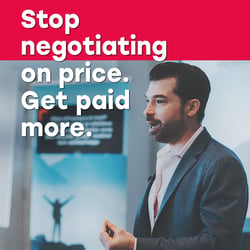B2B sales pros and business owners have all the potential they need to achieve each and every one of their sales goals. However, in order to live up to their fullest potential, they need to be conscious of the small mistakes that could potentially derail all of their progress.
When it comes to sales success, you are the solution... Not some fancy sales tool or software. Rather, it's you! But, that doesn't mean that you aren’t prone to letting your guard down and making a mistake once in a while.
That being said, one of the best ways to avoid making a sales-related mistake is to become conscious of the most common mistakes, even amongst experienced sales pros.
Therefore, to help you avoid letting a mistake overshadow your potential, we are sharing 10 B2B sales mistakes that can negate all of your efforts.
If you become aware of these mistakes, then you're less likely to make them.
It's like what they say... Learn from other people's mistakes so that you don't have to make them yourself!
In this case, learn from the sales mistakes others commonly make so you don't have to deal with the repercussions!
-Mar-09-2022-11-07-07-09-PM.jpg?width=717&name=1%20(1)-Mar-09-2022-11-07-07-09-PM.jpg)
1. Developing Extra Long B2B Sales Processes
Take a moment to put yourself in your prospect's shoes... If you were them, would you like to have your problem solved in more time or less time?
If you're like 99.9% of people, then your goal is to get your needs fulfilled in the least amount of time possible.
That being said, it is a major mistake to develop an unnecessarily long and complicated sales process, because it increases the amount of time it takes the prospect to get to a solution.
The last thing you want is to make your prospects say to themselves 'Is it over yet?'. Unfortunately, an extra-long process does just that!
Prospects Despise Long Sales Funnels
Do you like having your time wasted?
If not, then why would you waste your prospect's time by putting them through an unnecessarily long sales funnel (a sales funnel is the prospect's view of the sales process)?
Here's the thing: Don't take up any more of your prospects' time than necessary. Just like you, they're busy people too and don't have all the time in the world to sit through sales calls and presentations.
There is nothing better to prospects than a short and sweet sales process! More specifically, one that checks all the necessary boxes without complete overkill.
Respect your prospects by keeping your process at an appropriate length. If the process becomes unnecessarily long, you've given the prospect a simple reason to say 'no' to you.
Just Use Our B2B Sales Process Flowchart
Want to develop an effective B2B sales process but worried that it'll turn out longer and more complex than it needs to be?
If so, then just use our B2B Sales Process Flowchart as a guideline for your own process.
All you need to do is follow the flowchart to create an ideal process outline! As a result, you'll have an effective process that doesn't drag on for ages but still checks all the necessary boxes! Moreover, this flowchart has everything you need and nothing of what you don’t.
2. Not Taking Advantage of Social Media Opportunities
It's no secret that social media is a powerful sales and marketing tool, and that there are countless sales techniques and tools to make the most of it.
In fact, not using social media as a marketing tool is a marketing strategy in itself!
That being said, social media might not play the biggest role in your company's grand sales scheme, but that doesn't mean that you and your sales reps shouldn't take advantage of it on a personal level.
The truth is that some of the most effective sales tactics are those that individual sales representatives make use of on their own personal social media pages, particularly LinkedIn.
Therefore, not taking advantage of your personal media page is a big mistake because it keeps many potentially opened doors closed.
Small Moves On Social Media Can Make a Big Difference
Believe it or not, but sometimes all it takes to get a potential customer to slide into your LinkedIn DMs is to share the right content on your personal page.
What kind of magical content do we mean?
Case studies are among the best social content you can share because they give potential customers a sense of FOMO and social proof that your solution is effective.
Additionally, sharing some of your current customers' content on your personal page shows potential customers that you care about and have great relationships with your customer base.
These two sales tactics take a matter of minutes to do but can make all the difference in your results! Therefore, not taking advantage of them is a major mistake.
3. Waiting Till the End to Connect With Decision-Makers
Picture this: Lead generation goes great! You shovel an ideal customer into the sales funnel, and you're on your way to closing the deal. Now it's the final sales pitch, and you're ready to lay the deal on the table. But then, all of a sudden the prospect hits you with, "We need to get back to you!". The reason... They need to confirm with the top decision-makers at their company that they're ready to make a purchasing decision!
This exact scenario happens all too often in sales, and it stops many would-be simple deals from being made.
Yet, preventing this scenario is simple: All you need to do is connect with the decision makers at the B2B company right away, and then get them in on the final pitch! That way, when it comes time to make a buying decision, a deal can be reached then and there.
Cut to the Top Stakeholders Right Away!
Here's the thing: You need to connect with the top stakeholders who hold the decision-making authority right away in order to prevent a time gap between laying the deal on the table and getting a firm ‘yes’ to the deal.
The reason... The more time in-between you proposing the deal and getting a response, the lower the odds of the prospect giving you a ‘yes’. Because, when they have time to go back to the decision-makers, they have more time to reconsider your offer!
Even if you have an offer they can't refuse, their monkey mind will come up with plenty of reasons to say ‘no’ to you during that time gap.
Therefore, establish a solid touchpoint of communication with the decision-makers right off the bat in order to prevent a gap in time between laying the deal down and getting a firm ‘yes’.
4. Trying to Sell Facts Rather Than Emotions
Do you believe that B2B buyers purchase products and services based on the facts of the deliverable, or whether or not the deliverable satisfies their emotions?
If you chose the latter, then you are right on!
The hard truth is that B2B customers are emotional beings, just like you and I. While we all like to think we are super rational and make purchases based on whether or not they satisfy our tactical needs, we actually tend to make purchases based on whether or not they satisfy our emotional needs.
Unfortunately though, many sales pros make the mistake of trying to make sales based on facts rather than emotions. They go nuts filling their prospects in on all the mind-blowing tech specs of their deliverable only to have them walk out the door seconds later.
Don't make this same mistake... Start selling the emotional factors of your product or service rather than the tactical ones!
Facts Tell, Stories Sell
Now, you might be thinking... What is the best sales technique for using emotions to sell rather than facts? Simple... It's sales storytelling!
Sales storytelling is about turning your prospect's buying process into a buyer's journey in which you create a plot line out of their scenario. Think of it as a way of dramatizing their situation by putting it into a broader perspective.
While it might sound silly at first, storytelling is one of the most effective sales techniques in the playbook!
Want in? Check out our complete guide to telling stories in sales.
Give the Facts, Then Appeal to Emotions
Here's the thing: Just because people make purchases based on emotions doesn't mean you can bypass facts and technicalities.
Moreover, you need to give the low-down on the technical factors of your product or service before using emotions to try and close the sale.
Your customers need to know the tech specs of your product or service, but don't think for a second that they are the thing that will make them say 'yes' to you.
Furthermore, give your potential customers the facts they need to know, and then push them towards a closed deal by appealing to their emotions.
5. Not Developing a B2B Sales Strategy
Everything in B2B sales has a purpose.
There is no point in wasting time and energy on something in sales (and life) if it doesn't serve a specific purpose.
That being said, many sales teams make the mistake of not having any purpose at all. By that, we mean that they don't develop a sales strategy!
Think of a strategy as your 'why' for all things sales-related. You can't skip right to the 'what', which is your sales process, without having a 'why' first.
If you do make the mistake of directly skipping to the 'what', the greater the odds that your process will end up messy and flawed to say the least.
Use Our Sales Strategy Framework as an Outline
Many sales teams make the fatal error of jumping directly to the 'what' without having a ‘why’ first.
The straightforward resolution to this mistake is to simply develop a strategy before developing a process.
Thankfully, developing a strategy is easy when you use our Sales Strategy Framework as an outline for your own strategy.
All you need to do is follow the framework, and you'll end up with a perfectly put together strategy. Once your strategy is all lined up, you can move on to developing a process.
6. Not Dividing Up the Sales Pipeline Amongst Sales Reps
Every member of your sales team has their own unique talents. And those talents are typically best suited at different points in the sales pipeline.
For example, perhaps one team member is a cold calling pro while another member knows exactly what to do to qualify the best B2B leads.
That being said, divide up steps of the sales pipeline amongst sales reps according to who is best at which step. As a result, every salesperson gets to utilize their talents to the fullest extent.
Not only that, but dividing up pieces of the pipeline amongst team members saves a whole lot of valuable time! What could be better than that?
Allocate Steps of the Pipeline to Specific Sales Professionals
When developing your B2B sales cycle, decide which team member is most effective at which sales cycle step, and then put them in charge of it.
Failing do so so has several consequences that prevent you from closing deals, including:
- Not utilizing each team member's talents to their fullest extent
- Wasting the sales team's time and energy
- An overall messy and unorganized process
Make the simple choice to divide up your sales cycle! It's a little detail that can make all the difference in your success.

7. Negotiating
No, no, no, no, no negotiating!
Here's the thing... You want to be a nice person, right? More than that, you want to be kind to your prospects and help them solve all their problems, right?
While you might want to be nice (as you should), don't get it twisted... Negotiating your price point with prospects doesn’t necessarily mean that you’re being nice!
Why?
Because, by negotiating price with prospects, you inevitably damage the ensuing customer relationship with them by slashing your needs to accommodate them.
When it comes to building relationships with customers, keep this in mind: Your needs are just as important as theirs. And, when you drop your price point while keeping the deliverable at its original high value, it inevitably creates an imbalanced relationship.
Negotiating Cheapens Your Product or Service
There is no such thing as something for nothing in this world.
When you do a friend a favor, you get the positive feeling of having helped them. When you buy yourself a new pair of shoes, you give money equal to the value of the shoes to the seller.
The same can be said for B2B selling... When you give a product or service to your customer, you expect to get something of equal value in return for it.
Therefore, if you drop your price point for a customer without lowering the value of your product or service, you inevitably create an imbalance between the two of you. That imbalance ultimately damages the supplier-customer relationship.
While it might sound silly at first, think back to a time when you did a job for someone that you put 100% of your effort into, only to have them pay you what felt like a mediocre return. As a result, you resented them to say the least, and it damaged the long-term relationship you had with them.
Bottom line: You might feel generous negotiating at the beginning, but doing so will hurt your relationship with the prospect in the long-term. In the end, it'll only create a resentful relationship.
Be Confident In the Value You Bring to the Table
With that being said… How do you prevent negotiating with prospects in the first place, or stop it in its tracks?
In order to prevent a negotiation in the first place, you must be confident in the value of your product or service. By exuding confidence, prospects will see you as an expert in what you do and be less likely to propose a negotiation.
In order to stop a proposed negotiation in its tracks, consider offering flexibility instead. For example, propose a payment plan so that the prospect doesn't need to give you as much up front, and you still get the full value of your product or service in return.
8. Being Untruthful With Potential Customers
How many times have you been pitching your product or service to a customer when they all of a sudden hit you with the question... "How long before we start to see results?".
As the kind of sales rep who wants the absolute best for their customers, you of course want to help prospects solve their pain points in the least amount of time possible.
However, depending on what kind of business you run, the truth is that results sometimes take a matter of weeks or even months to appear.
For example, if you run a SEO services company, you know that it can take several months to see increased impressions and clicks. Not seeing immediate results doesn't mean that your services aren't working, but it does mean that it takes some time before the hard work manifests!
That being said, never lie to your prospects or give them unrealistic expectations about your product or service. Don't tell them that it will take 24 hours to see results when you know it will take more than that!
If you are untruthful, you might sign a deal with them, but eventually they will grow to resent you because your promises don't match the results.
In any case, it's always best to be straight-up with prospects. The last thing you want is for them to come after you with pitch forks because they found out that you weren’t telling them the truth!
Be the Expert Your B2B Buyers Need
Here's the thing: You are the expert on your product or service. More likely than not, your potential customers don't know virtually anything about it or how it works.
Therefore, it's your job to be the subject matter expert and tell your prospect exactly how things are going to be.
Believe it or not, but your business-to-business customers would rather have you be realistic and straight-up with them than anything. While they might not like all the answers you give them, they would rather you be honest because it shows that you truly are an expert.
Your prospects want to trust in you. Therefore, do what you need to do and say what you need to say in order to establish yourself as a trustworthy expert.
It’s Not What You Say, It’s How You Say It
If there's something you know that you must tell your potential customers, then say it. Even if it's something you know they probably don't want to hear, you still need to say it.
For example, if you know they want immediate results from your product or service but it will realistically take a month for results to show, what matters is less what your sales representatives say and more how they say it.
Every sales rep needs to have a sales approach rooted in honesty and that comes across as "I'm telling you this because I care about you and your success".
When delivering news or laying down the facts to your customers, just make sure that you say it in a way that comforts them!

9. Not Taking Advantage of Primetime Selling Opportunities
What is the best time of the year to make sales?
Believe it or not, but the best times for outreach are likely when you least expect it.
For example, some of the best times of the year to try and make new sales include:
- Right before the holiday season
- Near the end of fiscal quarters
Moreover, the best times to sell are right before a company is about to take a short break, before a major event, or before a change in seasons. Basically, it’s when there is a limited time window to jump in and make the sale.
Not taking advantage of these key time windows is a big mistake!
Don't listen to conventional sales advice that tries to tell you that it's 'too late' or 'not the right time' to try and make a sale because there is limited time on the clock. Because the truth is, those times are often the best of times to sell!
The Best Times to Sell Are the Least Expected Ones
What makes times like right before the holidays or a fiscal quarter ending such great times to sell?
Well, when it comes to the holiday season, prospects want to have solutions before the new year begins. They don't want to be scrambling on January 1st trying to fix problems. Rather, they want to hit the ground running, so they need your solution before the year ends!
When it comes to before the end of a fiscal quarter, many companies have capex budgets that must be spent before the quarter ends. And, what better person to come in and snatch up that remaining budget than a hungry sales rep with a valuable solution?
Jump In When Everyone Else Is Jumping Out
Here's the thing: If somebody tells you that it's not a good time to try and make a sale, then just know that it is probably the perfect time to jump right in!
Why?
Because, if everyone else is leaving your potential customers alone, that gives you a prime opportunity to jump right in front of them and get their attention.
While everyone else is making excuses, you're left with a goldmine of potential sales opportunities! Say a big thanks to all the other sales reps who gave up!
10. Thinking B2B Is Like B2C Sales
Are you new to B2B sales? Or, are you making the switch to B2B from B2C?
If so, then don't think for a second you can waltz right in and apply B2C sales tactics to the B2B process.
Because, the truth is that there are some major differences between B2B and B2C. Therefore, not getting the right B2B specific education is a big mistake!
Straight-up: If you are a hungry sales professional or business owner, you can 100% make it big in B2B. However, you need to not only learn the B2B ropes, but also get the empowerment you need to dive head first into the selling process with full confidence.
B2B and B2C Sales Success Come Down to Different Factors
There are certain fundamental differences between business-to-consumer and business-to-business sales, including:
- B2B involves building long-term relationships with customers whereas B2C relationships are short-term
- B2B has longer sales cycles than B2C
- The buying process for B2B customers requires more input whereas B2C customers require less input
Not recognizing these differences fundamental between B2B and B2C will ultimately result in many major sales-related mistakes.
Give Your Sales Team the Training They Deserve
Do you have a highly-motivated, top notch sales team who just need a little something extra to help put them over the edge of success?
If so, then B2B sales training is of the utmost importance!
It doesn't matter what your business goals are... Sales is almost always central to success. And it doesn't matter how great of a sales or marketing plan you have if you don't have fully empowered sales representatives to carry it out.
Therefore, give your B2B salespeople the sales enablement they need to not just check boxes, but become full-on sales problem solvers who know exactly what they need to do to get the best possible results.
Final Thoughts on B2B Sales Mistakes That Crush Sales Potential
Always try and learn from other people's mistakes so that you don't have to make them yourself!
Why make a mistake and derail your progress if you don't have to? Unless you're trying to shoot yourself in the foot, then there is no reason not to learn from others.
Remember, you are the solution to your business's success. You already have everything you need to reach your goals, now it's just a matter of not letting anything push you off course.
You May Also Like
These Related Articles

Everything You Need to Dominate B2B Sales | A Complete Guide

The Worst B2B Sales Mistakes that Shun Prospects + Simple Fixes




